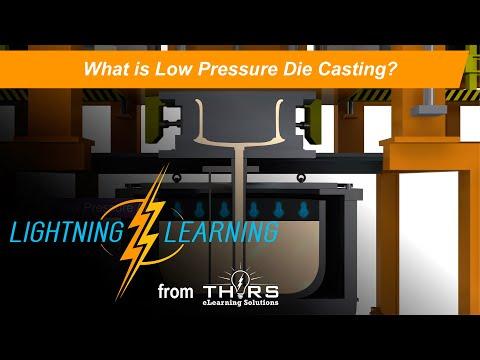This article offers a comprehensive analysis of low-pressure casting, covering topics such as its definition, history, how it operates, applications, advantages, and more. It discusses important subjects such as:Low-Pressure Casting: What Does It Mean? Casting under low pressure: a brief historyThe Importance of Casting at Low PressureTechniques Used in Low-Pressure CastingLow-Pressure Casting Metals and Their ApplicationsVarious Applications of Casting at Low PressureLow-Pressure Casting: Superior Quality and Long-Term DurabilityThere are both positive and negative aspects associated with purchasing low-pressure casting components from Diecasting-mould.com. Low-Pressure Casting: What Does It Mean? The process of low-pressure casting, also known as LP casting, is a method of casting metal in which molten metal is introduced into a mold while the pressure is relatively low, equal to or less than 0.8 bar. When compared to other casting methods, such as sand casting, this technique results in castings that are of superior quality and possess enhanced mechanical properties. As opposed to gravity die casting, low-pressure casting involves positioning the mold at or above the level of the molten metal throughout the process. Because it reduces porosity caused by trapped gases and shrinkage, low-pressure casting produces parts that are more durable than those produced by sand casting.
The slow filling that is free of turbulence helps to reduce defects
Beginning in the 1960s, early adopters in the United States of America, Japan, Germany, and Britain were the driving force behind the expansion of low-pressure casting around the world. The Importance of Casting at Low PressureThe significance of low-pressure casting lies in its capacity to manufacture intricate metal parts of superior quality, particularly aluminum alloys. When the mold filling is precisely controlled, turbulence and defects are reduced or eliminated. This makes it possible to have complex geometries and walls that are relatively thin (about 3 millimeters). The low-pressure casting manufacturing process is an important and versatile manufacturing method because it requires less machining, has improved properties, and is compatible with automation. Techniques Used in Low-Pressure CastingThe process of low-pressure casting involves the gradual introduction of molten metal into a mold while the conditions are controlled and low in pressure. The first step in the process involves machining a mold in order to replicate the shape and characteristics of the part. For the purpose of increasing productivity, permanent molds are frequently utilized. A preheating of the mold and the application of fluxes to clean its surface are both possible steps before casting.
As a result of degassing, trapped gases can be removed. After being melted in a furnace, the metal is then transferred to a holding crucible that guarantees that its temperature remains constant. The pressure inside the crucible is increased, and the metal is forced through a sprue and into the cavity of the mold. A controlled low pressure allows for a smooth filling process that is free of turbulence. For the purpose of preventing solidification, air vents allow gases to escape. Any shrinkage voids are filled by maintaining pressure throughout the cooling process. After the casting has been allowed to cool and solidify, the mold will open, and the casting will be removed. It is possible to produce the final part by performing additional trimming, machining, and finishing. Low-Pressure Casting Metals and Their ApplicationsIt is possible to process a variety of metals using low-pressure casting, most commonly:Aluminum (Al)This material is widely utilized due to its adaptability, low weight, and resistance to corrosion. Low-pressure casting is the dominant method. MagnesizationStrength-to-weight ratio is the criterion for value. Utilized in situations where light weight is vital. Copper has a higher melting point, which makes it less typical. When electrical or thermal conductivity is required, this material is utilized.
zinc (Zn)Excellent fluidity, low melting point, and the ability to cast intricate shapes were the criteria that led to its selection. Various Applications of Casting at Low PressureAluminum alloy engine blocks, suspension parts, cylinder heads, and wheels for automobiles are all examples of components that are ideal candidates for low-pressure casting because of their high-quality and complex nature. Electronics that come with heat sinkscomponents for industrial machinery, including housings for pumps, impellers, and gearbox casingsThe heads of golf clubsThe Low-Pressure Castings from Diecasting-mould.com are of High Quality and Long-Lasting DurabilityLow-pressure casting, when carried out correctly, ensures the production of long-lasting components with low porosity defects. Turbulence and voids are reduced to a minimum through controlled filling and pressure. Low-pressure castings have the potential to have long and dependable lifespans if they are made with high-quality materials, designs, and processing. Comparing the Benefits and Drawbacks of Low-Pressure Casting ProcessOther important benefits include:Extremely high dimensional precisiondecreased porosity and gas inclusions to a minimumDuring the filling process, there was less turbulence and oxide formation. Improvements in the mechanical propertiesA reduction in the amount of waste materialeconomically viable for batches of small and medium sizeAmong the disadvantages are in:Less rapid filling of the mold compared to high-pressure castingA possibility of erosion occurring in the risers and cruciblesConsumption of more energy than that of more straightforward methodsA significant initial investment in the machinery and tools utilisedRequires professionals to operate itGet in touch with a manufacturing expert at Xometry right away to acquire additional information regarding low-pressure casting.

